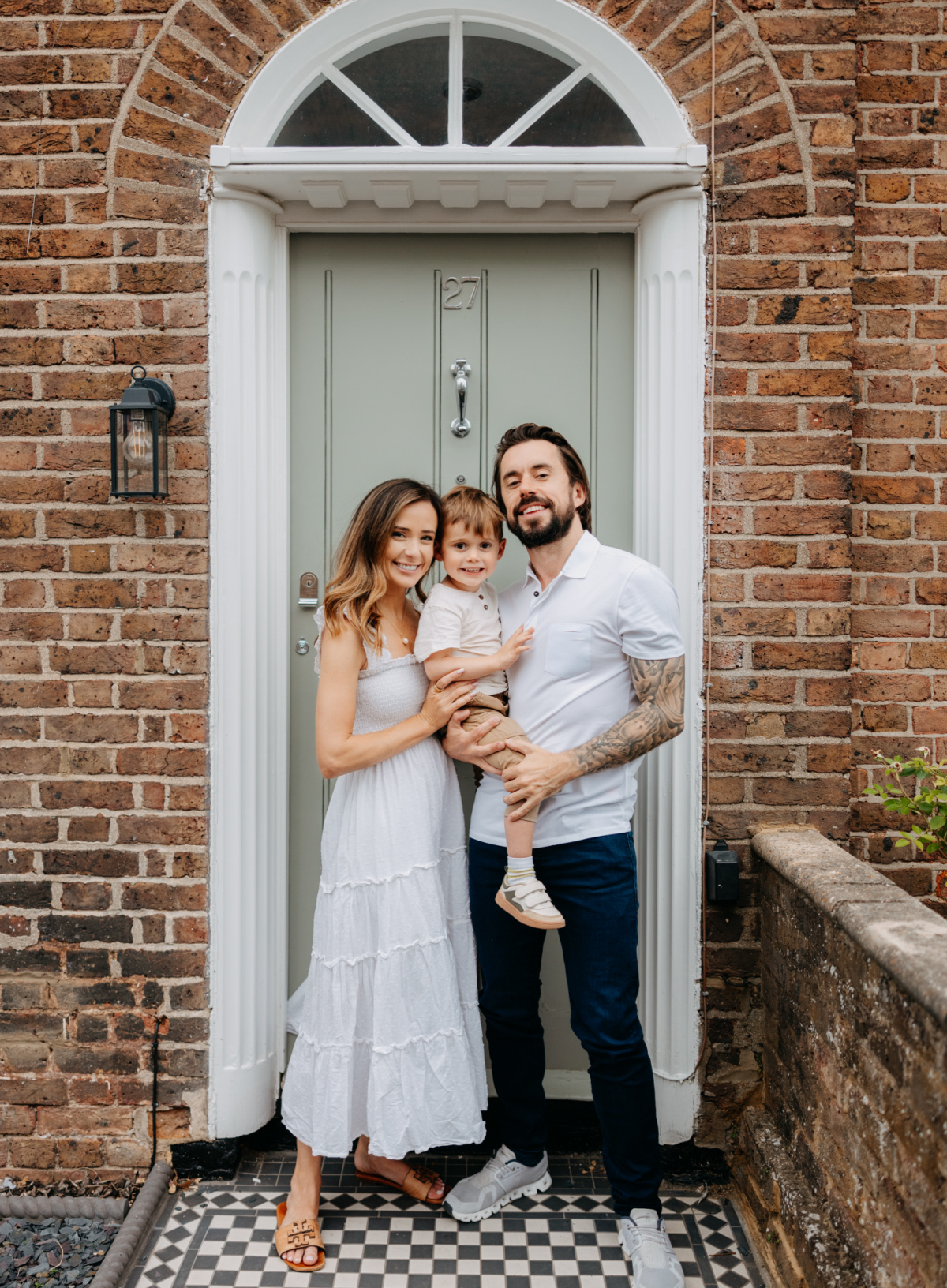Hi ladies, happy Thursday! This wasn’t a post I was going to write so soon because I’m still very much in the midst of postpartum and C-section recovery journey, but based on the conversations I’ve been having with y’all in my DMs [especially you pregnant mommas], this is a topic you really want to hear about so I’ve rounded up some thoughts and products that I hope are helpful. Plus, it was also recently brought to my attention that April is C-section Awareness Month, and after having had a C-section, I definitely want to take a minute to recognize any moms that also have had that experience – you are my heroes!! Many of you didn’t choose that birth path and I know there is some mental hoops to jump through afterwards. I’m with you. I get that. And, there are those of you who have a deep fear of delivering vaginally so this is the route that felt safest for you and your baby. No matter the reason for your C-section, remember that your scar was a door to life for your baby and you are a warrior.
This post will mainly focus on my C-section recovery essentials, along with some tips, but it’ll also include other postpartum items that might be helpful, like what I purchased for vaginal delivery recovery. I thought about including items for feeding, like nipple balm and the bottles we liked, but I think I’m going to include that in a separate post! I hope this is helpful and answers any questions y’all might have but if you have more, feel free to send me a DM on Instagram or leave a comment below if you feel comfortable!
Items Needed For C-Section Recovery
THE UNDERWEAR SITUATION
Regardless of the type of delivery you have, you will bleed for about four to six weeks after your baby is born. It is completely normal and everyone has their own preference on what they’re comfortable in regard to underwear. I got multiple suggestions and I tried them all so I’ll leave them below for you to marinate on and decide what could work best for you.
– ALWAYS DISCREET UNDERWEAR: Okay, I had no shame in my game wearing these! Quite a few of y’all recommended them and I was really … I mean, really … not sure about whether I should try them or not but, I am so glad I gave them a try because they were SO comfortable. It definitely feels like you’re wearing more than underwear but I just wanted to be covered from a leakage perspective and they had me covered there, ha!
– WASHABLE MESH UNDERWEAR: In the U.S., I hear that they give you these in the hospital and they’re amazing. I bought mine on Amazon and wore them for about two weeks after I retired from the Always Discreet Underwear [I.e. after my bleeding went down quite a bit]. Being that they don’t have a pad in them, you will have to put your own pad in so I’ll get into that next. But, overall, the mesh underwear is super comfortable and I highly recommend the washable ones because it cuts down on waste.
After you’ve graduated from these, I personally liked these ‘under belly’ underwear but, if you want your stomach covered, I probably would opt for these as they’re seamless and seem like they wouldn’t be too tight. I tried this set of postpartum underwear and I think I ordered a size too small because they compressed my belly too much and made me uncomfortable.
PADS
Obviously, to absorb the bleeding, you’ll need pads. The amount you bleed can fluctuate day to day so you may need to have multiple pad options to choose from.
NATRACARE PADS: These were amazing right after delivery. My friend recommended them to me. They were super absorbent and comfortable. I used these for about a week but, obviously, everyone’s bleeding is going to be different. I thought they worked best for those heavier days.
HONEYPOT POSTPARTUM PADS: Is it weird to say I miss these pads? They have a cooling sensation thanks to the witch hazel in them making them a total game changer! They were great for me when bleeding had gone down a bit, as they are a thinner pad, but would also be amazing for post-vaginal delivery as that area will have quite a bit more swelling. Witch hazel not only feels great but is amazing and alleviating swelling and fights bacteria so no matter which delivery you have, I’d recommend these.
PAIN MANAGEMENT
IBUPROFEN & TYLENOL: I took 800mg Ibuprofen around the clock as well as Tylenol. As a former pain management nurse, I can’t underline how important it is to take your pain medicine around the clock for the first four or five days. Even if you think you don’t need it, it’ll be good to keep it in your system. It’s harder to get it under control if you skip doses.
SNUGGLE ME LOUNGER & COVER: If you’re breastfeeding, utilize your partner when it comes to night feeds and your baby is sleeping in a bassinet by having them bring baby to you. This will minimize you attempting to get up more than you need to. But, if you need to make things easier on both of you, baby can rest in the lounger next to you while you sleep. Side note: If you know you’ll be having a C-section, I highly recommend a bassinet like THIS ONE but I’d still have it on your partner’s side of the bed to make things easier on you.
NURSING PILLOW: Your stomach is going to be very tender so having your baby lay on the nursing pillow will feel more comfortable. Make sure you’re keeping up with your pain management, though, because it’ll still be a little uncomfortable!
CONSTIPATION PREVENTION
COLACE: If you can, start taking stool softeners a week or so before you deliver. If not, start the day you deliver so you can prevent things from slowing down after your surgery. [Surgery naturally does that!] Gas makes your pain worse so be sure to get ahead of constipation. And, as I mention below, maintain a diet high in fiber to aid in digestion, as well.
HEMORRHOID TREATMENT
Ah, what a glorious topic: hemorrhoids. I didn’t have any issues with these after birth but I did before giving birth to Louie and they are not comfortable so, I thought – even though it’s not fun to admit – it’d be good to just touch on what to do when / if you do experience them. We have Anusol [suppositories and cream] here but, in the US, Preparation H [cream] treats them, as well. You can also use Tucks for comfort. Sitz baths are also something you can do to get relief if they’re really bad.
BINDERS
In the U.S., I heard that some hospitals give ladies who have had C-sections abdominal binders to make you feel more comfortable. I actually purchased one on Amazon but decided not to use it being that my stomach was so sore and I just didn’t want anything touching my stomach. The point of them is to help your incision recover and heal but mine never bothered me and I felt like the Always Discreet underwear was really gentle against my skin. It didn’t irritate my incision at all. So, I’ll let you decide if a binder is right for you. I can’t really recommend one either way but including here as I know it’s something many ladies recommend.
Tips For C-Section Recovery
• Have someone on hand with you for at least two weeks. C-section recovery is truly no joke. You will ALWAYS need help out of bed. I needed help out of the shower a few times. You will need help getting comfortable when you lay down, when you nurse your baby or when you need to get a bottle ready, when you do anything! Do not underestimate the fact that you will need help when you get home. So, if help is offered, don’t turn it away!
• Rest as much as you can but don’t allow yourself to be bed bound. You’ll need to get up to go to the bathroom. At that time, also challenge yourself to walk out and around your living room or on whatever floor you are on in your house. These short walks in the beginning are good for your circulation and your muscles. It also helps to prevent blood clots and moves gas through your bowels.
• Maintain a diet high in fiber as well as lots of water. Avoid foods that give you gas and drinks with carbonation.
• Keep taking your vitamins. I take Ritual’s Postnatal vitamins to continue to get the nutrients my body is needing and / or lacking right now. Also be sure to take whatever supplements are prescribed to you from the hospital. For example, I didn’t lose a ton of blood but I tend to have low iron levels so I took an additional iron supplement when I got home. Enjoy 10% off your first three months with code HALEY.
• Have a diaper caddy next to your bed or set up a changing area in your room. We have a bay window with a large seat that we made into a changing station with one of the diaper bag changing mats that I had bought. I ordered more of these baskets to put diapers, hand sanitizer, diaper cream, wipes, and pacifiers in to make changing easier. I’m not going to lie, John did a lot of the diaper changes in the beginning but having everything in our bedroom made the process even easier no matter who was tackling it.
• Have a small pillow handy to press against your stomach when you cough, sneeze or laugh because they are all really uncomfortable.
• With that said, be very careful when you sip water so it doesn’t go down the wrong way. This kept happening to me and it was so painful to cough! I always had my Yeti tumbler next to my bed full of water. I don’t think I had ever been so thirsty for the first two weeks after my C-section.
• If you’re feeding baby formula, I’d recommend having your significant other take night shift and allowing you to get a good nights’ sleep. Your body needs it to recover.
• Keep all the essentials within arms reach.
• Around day two or three after your surgery, you’ll pee A TON … like, rivers in one sitting every time you sit down to go. This is normal.
• You will likely experiencing period-like cramps at some point in your recovery as your uterus starts to shrink back down. I had to lay down and take a nap one day because they were so uncomfortable so just know that that is very normal.
Vaginal Delivery
Like I said above, I did not end up having a vaginal delivery but I did so much prep for one that I still want to share everything I thought would be useful during that recovery. For the products, I found that so much of what I bought is disposable, which I understand to a certain degree, but I tried to find some reusable items to use to minimize waste. If you’re a vaginal delivery mom and have anything you’d add to this list, please share in the comments so we can all benefit!
Items Needed For Vaginal Recovery
Like I mentioned, I fully anticipated having a vaginal delivery so y’all… I had EVERYTHING ready to go for a vaginal delivery in a little basket next to our toilet in the bathroom. Granted, at least I know what I’ll need if I’m able to have a successful VBAC in the future. Just so you know – you’ll need to refer to the ‘underwear’ and ‘pads’ section of C-section recovery, as well. You’ll need those! Here’s what else you’ll need:
ALL THE THINGS FOR ‘DOWN THERE’
ICE PACKS: After delivery, it’ll be swollen and a bit uncomfortable down there! Ice will help alleviate the swelling and offer you tons of comfort. I’m pretty sure the hospital will supply you with ice packs but, just in case, you can bring a few of these with you if you want or the FridaMom Postpartum Essentials Kit, which I’ve heard has a lot of what you need. I had purchased these reusable ice packs for when I got home from the hospital had I had a vaginal delivery instead of the disposable ice packs. After each use, simply put them in a plastic container and sterilize with boiling water. Wipe dry then put back in the freezer to use again. We have a kettle that makes sterilizing take no time at all so I realize that might be quite the task for some but, it is more environmentally friendly so thought it’d be worth doing and recommending!
PERI BOTTLE: This is a must have from what I’ve heard as it can be really uncomfortable to urinate after delivering vaginally. This helps it feel much more comfortable. Simply fill with warm water and sprays as you go. They will give you one of these in the hospital but this particular peri-bottle is better than the rest because of how it’s designed. It really allows you to aim the water where it needs to go, if you know what I mean, unlike the ones you get from the hospital.
TUCKS PADS: Line your pad [on top of the ice pack] with these Tucks pads, infused with witch hazel, which helps with swelling and fighting bacteria. If you’re able to put them in the freezer or refrigerator for a bit beforehand, do that! The cooling sensation will feel so good down there!
PERINEAL HEALING FOAM: I had a friend who also recommended a perineal healing foam to be squirted on top of the Tucks to offer even more healing relief. I can’t say whether it’s necessary being that it seems the Tucks do something similar but, it could be beneficial, especially if you had a tear. It’s included in this FridaMom Postpartum Kit, so maybe that’d be worth getting instead of buying everything separate. I’ve also heard they have a lot of these things for you in the hospital so maybe just have this ready for you when you get home!
And, just like with a C-section, you’ll want to stay on top of constipation prevention by taking stool softeners starting before you go into labor but, at the latest, just after giving birth!
Whew, that was a lot, but I really want these kinds of posts to be resources for anyone expecting or currently in the throws of postpartum life. Are there any other specific motherhood/birth/postpartum topics you want me to cover? Let me know! xo.













